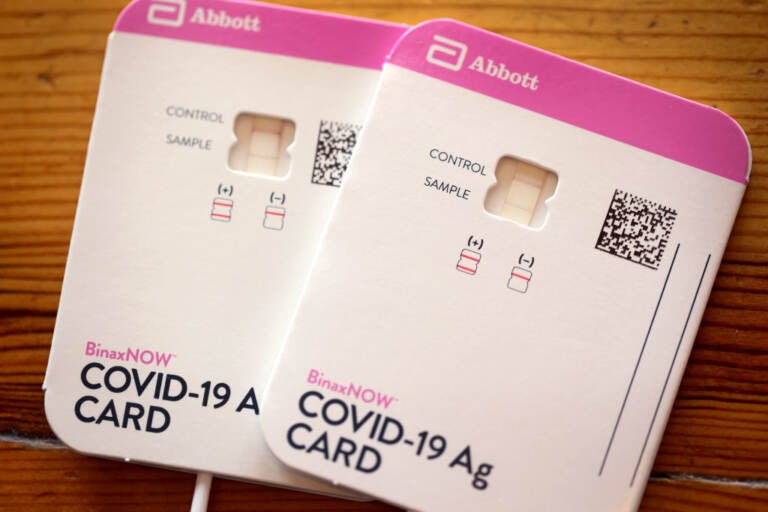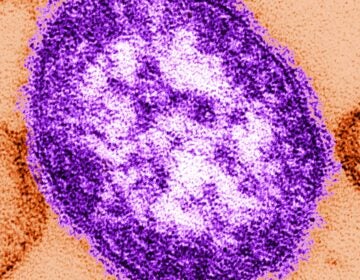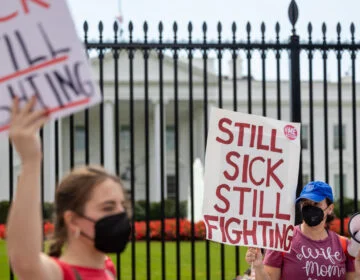How the U.S. got on the slow track with at-home COVID tests

In this photo illustration, An at-home COVID-19 test by Abbott shows a positive result on September 14, 2021 in Chicago, Illinois. (Photo Illustration by Scott Olson/Getty Images)
Dr. Kavita Patel wishes navigating the pandemic could work for her patients like it does across much of Europe, where take-home COVID-19 tests are free or virtually free, and so widely available that people can use them every day — before going to work, or a party.
“Shouldn’t this be so damn easy that there’s very little friction to getting a test?,” says Patel, a fellow at the Brookings Institution and a practicing physician at a federally-funded health clinic in Washington, DC. “The answer should be: Yes.”
But it isn’t. Similar over-the-counter tests cost $7 to $15 a piece — far more than Patel’s mostly low-income patients could afford — and supplies are limited, which frustrates Patel. She argues fast, frequent testing is critical, especially as cases surge again ahead of the holidays.
The very delayed U.S. rollout of rapid, easy-to-use COVID tests that has confounded public health experts. With surges rolling across the country, prompting more hospital overcrowding, and the prospect of a new, little-understood variant, the Biden administration has once again come under pressure for not increasing widespread availability of at-home tests.
It recently pledged to distribute 50 million free at-home tests through libraries and clinics like Patel’s. It’s also said people with private health insurance will soon be able to apply to get costs for the tests reimbursed.
But for Patel, those measures come too little, too late: “I am sitting here, December 2021 — we’re going to get hit with a surge, it is inevitable — and why am I sitting here trying to figure out when I’m getting tests?”
The answer goes back to the U.S.’s approach at the start of the pandemic. The U.S. government — under both Trump and Biden — didn’t oversee and pay for universal at-home testing the way it did with vaccines.
While the government does pay for the more-expensive PCR lab tests for anyone who is uninsured — and has required insurers to cover them with no co-pay since the start of the pandemic — it hasn’t put a similar system in place for at-home rapid tests.
That was a pivotal mistake, says Michael Mina, a well-known expert in testing and former Harvard epidemiology professor. He now works for eMed Digital, an at-home diagnostic company.
“Every step we’ve taken in the pandemic has assumed that this is a medical problem…but it’s a public health problem,” Mina says. Just as the government did not require individual Americans to pay up front to get immunized, so, too, it should have distributed and paid for at-home tests to keep the general population safer, he argues.
Late last month, the state of New Hampshire tried that approach. It partnered with the federal government to offer 800,000 free tests to residents, delivered through Amazon. Those supply of tests ran out in one day.
Mina says that should’ve been done across the country.
“Why not make it simple and streamlined?,” Mina says. “I don’t have a good answer as to why they’re choosing not to.”
Instead, consumers have to navigate the process on their own, whether it’s locating limited supplies available at drug stores or on sites like Amazon, or filing for reimbursement if they have private health insurance, or trying to find sites like rural clinics and libraries where the federal government is sending free take-home tests.
Another factor affecting both availability and prices of tests in the U.S. is its regulatory approach; it lagged in authorizing and manufacturing the tests, taking longer than other countries.
“One reason the price here is a little higher [is] because you need to spend more; you need to spend more studies and on clinical trials,” says Jack Feng, chief operating officer at iHealth Labs, which last month received emergency use authorization from the Food and Drug Administration to sell its tests.
The FDA has greenlit 13 over-the-counter tests to date (including both antigen tests and some rapid molecular tests), and a majority — eight of them — received those authorizations in the last two months. It can then take another few months to get factories to produce them.
iHealth partners with Chinese manufacturers that are already up and running, so it was able to start selling its kits online within four days after getting the go-ahead from the U.S. government.
But companies authorized earlier, like Abbott Laboratories –one of the largest makers of over-the-counter tests — rushed to set up two U.S. factories in three months, instead of the two years it would normally take.
And, several months after its factories got up to speed, cases of COVID began to abate, and with that, and demand for tests in the U.S. plummeted. So Abbott shut down one of its factories and laid off workers. Now Abbott has once again had to switch course as a new surge creates new demand.
Meanwhile, the lack of reliable supply of cheap and easy-to-use tests has made it hard to incorporate testing as a part of public policy.
Elizabeth Stuart, a public health professor at Johns Hopkins University, argues that fewer children would miss school after exposure to COVID, if there were more more tests. Instead of staying home, they could test daily prior to going to school.
“I’ve been pushing DC public schools on this, and I will say it’s been hard to push on it because of the supply problems, they sort of say, ‘We just can’t get enough tests to implement that,'” Stuart says.
There are other important uses for them, as well. People could be testing before indoor social gatherings, or before visiting relatives over the holidays. And Stuart says, rapid testing will be key for using the highly anticipated antiviral drugs from Pfizer and Merck, which are more effective if taken soon after infection.
“Knowing that you’re infected with COVID quickly can help make sure you get the right treatment quickly,” she says.
9(MDAzMzI1ODY3MDEyMzkzOTE3NjIxNDg3MQ001))




